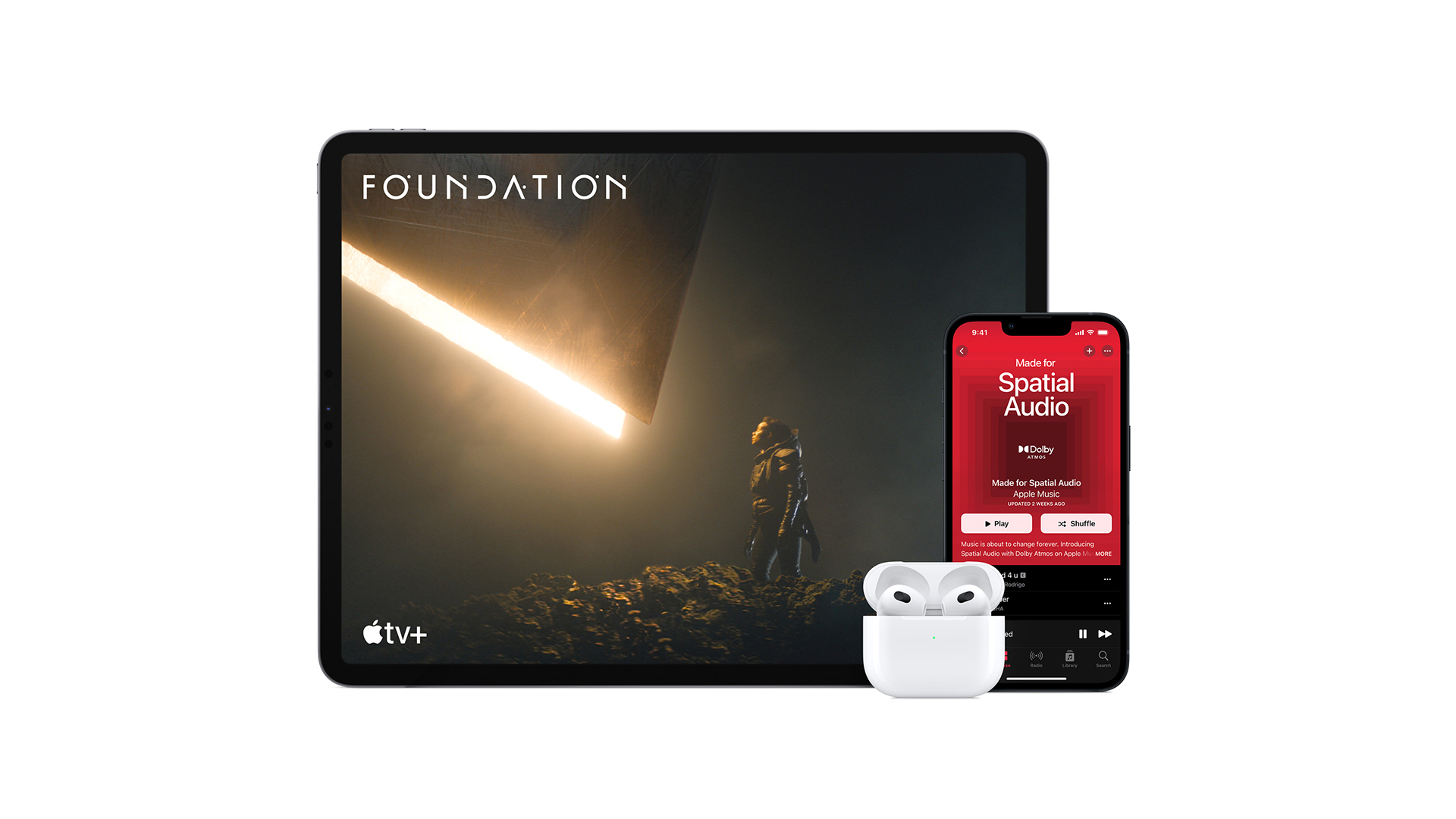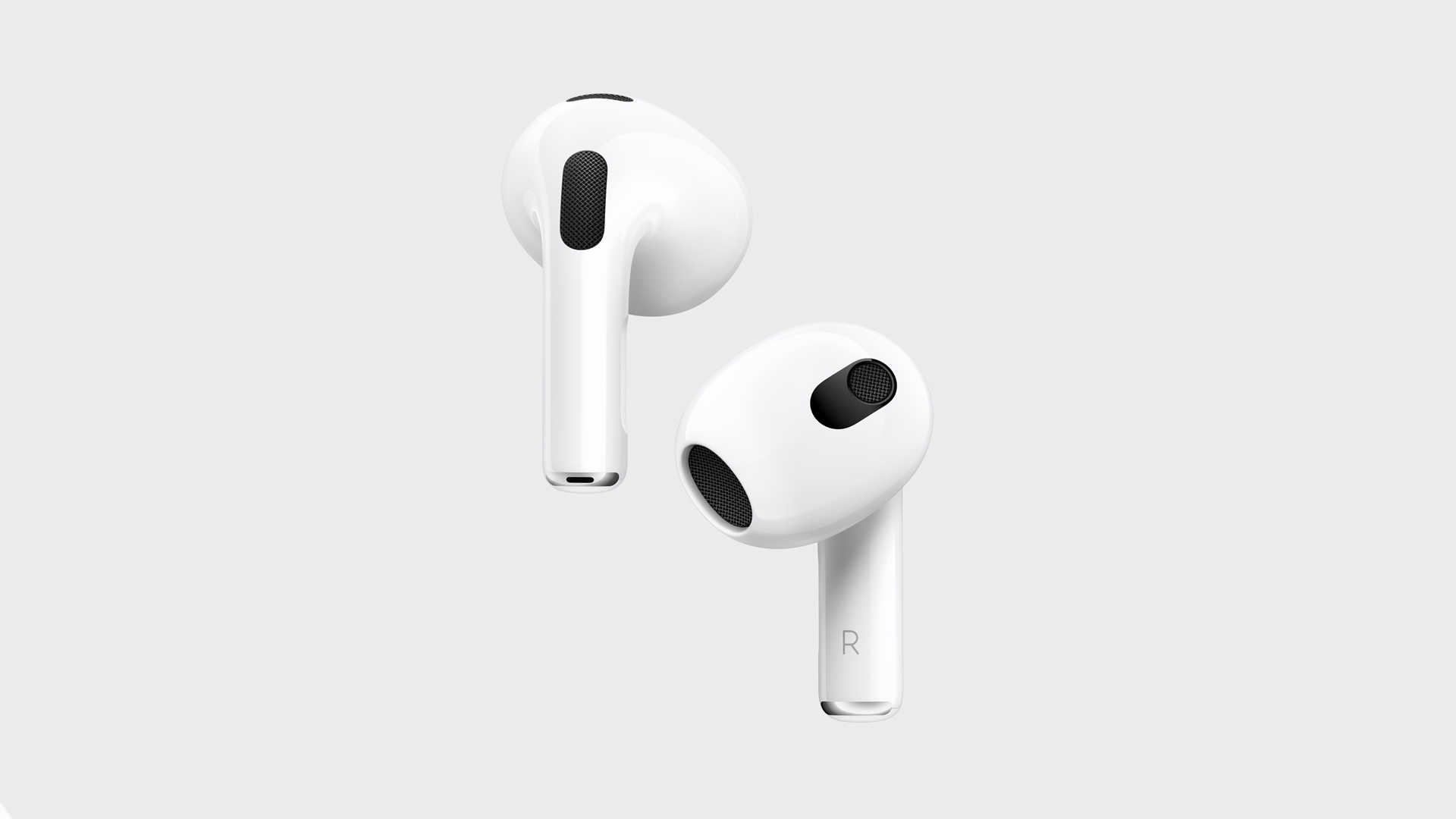What Hi-Fi? Verdict
While better-sounding alternatives exist, the AirPods 3 are daily delights with a strong selling point in spatial audio
Pros
- +
Spatial audio support is a real bonus
- +
Balanced, clear and detailed sound
- +
Strong battery life
Cons
- -
Beaten for transparency
- -
Still no on-bud volume adjustment
- -
Fit won't be for everyone
Why you can trust What Hi-Fi?
Apple hardly needed any ‘third time lucky’ well wishes for its AirPods 3. It’s estimated that more than 200 million pairs of AirPods have been sold in the five years since the first model arrived – that's roughly half the number of official Rubik’s Cubes (the best-selling toy ever) that have been sold over four decades, to put it in perspective.
While brand affinity has naturally played its rather large part in this, there’s no denying the AirPods’ success has also been down to Apple’s flawless ‘it just works’ technology – and the third-generation AirPods are the latest incarnation of that ethos, with a stand-out feature thrown in as a final flourish.
Here, Apple has brought its ‘standard’ wireless earbuds much more in line with the premium AirPods Pro, which remain superior over the AirPods in fewer ways now than before (a gap the AirPods Pro 2 are expected to once again widen). Such evolution basks in an air of both inevitability and sensibility, but how does that fare against the increasing – and increasingly good – competition that has upped its game in desperation to take what’s left of the AirPods-dominated market?
- Can't decide between AirPods? Check out our AirPods 3 vs AirPods Pro (1st Gen) and AirPods 3 vs AirPods Pro 2 comparisons
Price
The AirPods 3’s launch price of £169 ($179, AU$279) was slightly higher than the launch price of their predecessors, which remain current in the line-up with an official price drop to £119 ($129, AU$219) – the price they’ve actually been available at for some time. That makes the new AirPods middle-sitters in Apple’s three-strong true wireless earbuds range, below the AirPods Pro, which are now officially £239 ($249, AU$399) with the new inclusion of a MagSafe wireless charging case.
Now that the AirPods 3 have been out for some time, they can often be picked up for 10 to 20 per cent less these days, so we'd urge you to check the best AirPods deals.
The true wireless earbuds market seems to have somewhat settled on a price division in recent times, with models without noise-cancelling around and below the £120 ($150, AU$250) mark and those with noise-cancelling above that, up to the AirPods Pro, Sony WF-1000XM4 and Sennheiser True Wireless Momentum 3 of this world. That makes the AirPods 3 appear expensive in the non-noise-cancelling segment, but then again none of the rival AirPods alternatives – the Cambridge Audio Melomania 1 Plus, for example – have quite the flurry of features, especially for Apple device owners.
- See the best AirPods deals on the internet
Features

Unsurprisingly, the new AirPods, like their Pro and Max siblings, don’t support the lossless (CD-quality and above) audio now offered in the Apple Music catalogue, due to the inherent restrictions of their AAC Bluetooth codec support. While there’s certain controversy to that technological conflict that will likely hang over Apple’s head until it launches compatible headphone hardware, it seems unfair to talk about what features the AirPods 3 overlook considering they take advantage of so many – including Apple’s arguably buzziest audio innovation in years. Spatial audio arrived for movies and TV shows as part of iOS 14 in September 2020, and this summer expanded to music through its alliance with Dolby Atmos. For the uninitiated, Spatial audio uses 3D audio algorithms, applying directional audio filters to subtly adjust the frequencies that each ear receives, so that sounds are placed all around the soundstage to create a more immersive effect.
The latest hi-fi, home cinema and tech news, reviews, buying advice and deals, direct to your inbox.
While spatial audio music can be enjoyed by any pair of headphones, the AirPods 3 join the AirPods Pro and AirPods Max in exclusively offering the full spatial audio experience. That’s because they boast accelerometers and gyroscopes to track the wearer’s head movement so that sounds can be positioned accurately and relative to the Apple screen you’re watching on. This dynamic head tracking bonus means that if you turn your head or reposition your device, dialogue will still be anchored to the actor on-screen – and if that sounds pretty cool, that’s because it is. In reality, there will probably be few occasions where you have to move your head or screen much while watching a movie or TV show, but when you do, the technology is true to its word, keeping voices and action tied to the screen regardless of movement. We watch See on Apple TV+ (Netflix has also rolled out support for spatial audio for its iOS app) on an iPhone 13 while cooking, and as we move our head to the right the soundscape tilts towards the left earbud – subtly but effectively.
- 11 of the best spatial audio tracks in Dolby Atmos on Apple Music

Battery life 30 hours
Water resistance IPX4
Features spatial audio, Audio Sharing, MagSafe wireless charging
Bluetooth AAC, 5.0
Weight 4.3g (each bud), 38g (case)
The ambush scene in the first episode of the Jason Mamoa-starring dystopian thriller is much more involving when the sound is ‘spatialised’ – the soundstage opens up so that falling boulders sound more dramatic, and even the extra envelopment of heavy rainfall makes for a more compelling audiovisual experience. Similarly, in the final scene of the second episode of Invasion, where army troops get trapped in a storm of debris, it’s a much more claustrophobic and affecting experience with spatial audio activated.
Our appreciation of the technology with music isn’t quite as blanket. Surround processing effects can naturally sacrifice the focus of vocals, and while that isn’t obvious with the films we try, it’s more apparent with music. We spend hours delving into Dolby Atmos-powered spatial audio tracks – from Kraftwerk and Lorde to Ludovico Einaudi and the Beatles – and find ourselves preferring stereo presentations for some, spatial audio for others. You lose some of the directness, immediacy and often musicality that the stereo presentation delivers, but in return, especially when tracks are mixed well, you can get a truly unique (and sometimes exceptional) atmospheric boost from the immersive surround-sound mix that’s much more than a gimmick – just as you can with Atmos tracks on Tidal.
More familiar AirPods features also return, powered by the same H1 chip – although the AirPods do require Apple devices running the now available iOS 15.1, iPadOS 15.1, watchOS 8.1, tvOS 15.1, or macOS Monterey.
Audio Sharing, which allows an Apple device's audio to be played simultaneously through two sets of AirPods, Pro or Max, is present and correct, as is the commonplace auto-pause function. The AirPods now take advantage of the Pro's Adaptive EQ feature too, meaning the earbuds adapt their sound in real-time based on how they fit in your ear.
Apple has also worked to improve voice call quality, firstly by bringing in support for a codec called AAC-ELD, specifically designed to enhance speech, and secondly by covering the beamforming microphones on the earbuds with an acoustic mesh in an effort to reduce wind noise.
Apple could’ve kept the AirPods 2’s 24-hour battery life and remained largely competitive in today’s market, but it has taken it to an above-par (albeit not class-leading) 30 hours: the buds themselves now offer six hours (up from five) and the charging case is able to re-juice them four times before needing a charge itself via the Lightning connector. Just note that the earbud battery figure will take a slight hit depending on volume level and if spatial audio is deployed. Handily, a five-minute ‘quick charge’ should be enough for an extra hour of juice, too.
The one available charging case, compatible with MagSafe wireless chargers, harks back to the original AirPods – curvaceous and squarish, and noticeably narrower than the Pro’s. We’re pleased Apple has not only made the earbuds IPX4-rated water and sweat resistant but also, for the first time, given the charging case that same level of protection against water splashes.
- These are the best AirPods alternatives you can buy
Design

The buds themselves also take their cues from an existing AirPods design – the Pro. As was consistently rumoured in the long build-up to their reveal, the AirPods 3 ditch those ludicrously long, earring-like stems in favour of the shorter stems of their noise-cancelling sibling.
The buds are very slightly and imperceptibly smaller in every dimension and a single gram lighter too. They have subtly different contouring, but the biggest difference is their omission of the Pro’s interchangeable silicone ear tips, which we prefer for their secure fit and seal. The natural unintrusiveness of the AirPods design will be welcome to those who don’t like their ears being stuffed with silicone, but the fit isn’t for everyone. Most people on our reviews team got on with it like a house on fire, some complained that after a while their inner-ear cartilage felt like it was on fire.
With the neater stems come the same touch controls, courtesy of force sensors on the stems that can be gently squeezed to control music playback and calls. While the AirPods 2 required a double-tap on the earbuds’ body to play music, skip forward tracks or answer a phone call, the AirPods 3’s controls are more versatile and mirror those of the Pro – squeeze the stem once to play, pause or answer a phone call, twice to skip forwards, and thrice to skip backwards. Instead of a press-hold action switching between Active Noise Cancellation and Transparency mode in the Pro, here it activates Siri.
Our time with the Pro over the past two years has seen us grow more comfortable with the stem-squeeze motion, which is just as responsive here. But we stick by our initial comments that we wish the controls were less involved – squeezing stems isn’t easy to perform when exercising, for example. We’re more disappointed that on-bud volume adjustment remains on the wishlist.
- Everything we know about the AirPods Pro 2
Sound

New features, new design – and new sound? There’s certainly a genetic likeness between the AirPods 3 and their predecessor where sonic character is concerned: the new "low distortion" driver has also been tuned to produce an easygoing balance that doesn’t unduly favour any part of the frequency spectrum. Like many of us in the past two years, though, the new AirPods have taken on extra weight – they’re now slightly fuller in general, with a bolder bass and smoothed out top end sandwiching a lush midrange. That bottom end is more shapely and precise too, giving basslines a sharper kick and helping to will them along.
The leap from second to third generation is defined by greater clarity and cleanliness, too – everything in the presentation is that bit more present and organised – and Apple has been sure to make headway in terms of insight too. It’s evolution over revolution, but that is OK. We’re fans of their neutrality and clarity, and the AirPods sound better than the cheaper crop of ANC-less competition. We still find they fall victim to harshness and congestion when their volume is pushed, although that isn’t uncommon in the market.
The Pro are still the best-sounding in-ear AirPods, mind you, with more space and dynamic expression making for a more compelling delivery. The also-premium, also noise-cancelling Sony WF-1000XM4 take that even further as the market class leaders by being significantly subtler in their delivery and, courtesy of a tighter handle on rhythms, more musical. And it’s worth noting that the older WF-1000XM3 (still just about available and cheaper than the AirPods at the time of writing) come out sonically on top against both pairs of Apple buds too.
Verdict
In their third generation, the AirPods are very much familiar faces but ones that have a new hair-do or job promotion glow about them, thanks to their improved sound, innovative Apple-centric features and Pro-inspired redesign.
The AirPods Pro still justify their existence with superior sound, ANC and fit-friendly eartips. And you have to believe that the increased parity between the models now won’t last too long anyway, with Apple expected to next year launch a second-gen Pro which will undoubtedly pull away once more, as it should, from the standard model that has now sidled up fairly close to it.
The AirPods 3 aren’t the best-sounding earbuds out there and are pretty pricey for a pair without active noise-cancelling in today’s competitive market. They won’t be for everyone fit-wise either and, of course, they still hugely favour Apple device owners. But generally, third time proves a charm here. The new model is bound to continue the AirPods sales’ upwards trajectory towards Rubik’s Cube popularity, and we can’t say it doesn’t deserve to.
SCORES
- Sound 4
- Features 5
- Build 4
MORE:
Read our Sony WF-1000XM4 review
Apple AirPods 4 vs AirPods 3: what's new and which is best?
Everything you need to know about the new AirPods 4
Go behind the scenes: How the AirPods 3 were made – and how Apple plans to make them even better
AirPods 3 vs AirPods 2: should you upgrade?
Keep them clean: How to clean AirPods
What Hi-Fi?, founded in 1976, is the world's leading independent guide to buying and owning hi-fi and home entertainment products. Our comprehensive tests help you buy the very best for your money, with our advice sections giving you step-by-step information on how to get even more from your music and movies. Everything is tested by our dedicated team of in-house reviewers in our custom-built test rooms in London, Reading and Bath. Our coveted five-star rating and Awards are recognised all over the world as the ultimate seal of approval, so you can buy with absolute confidence.


